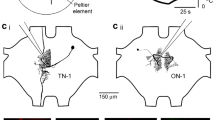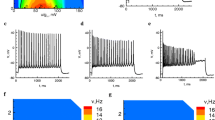Abstract
Sensory input to the central nervous system begins with a transduction step, specialized to the sensory modality involved, resulting in the production of postsynaptic electrical input to the outermost branches of a dendritic tree. Spatiotemporal summation of this ‘slow’ input as it converges upon the axon then initiates the production of or modulates the rate of ongoing production of ‘fast’ neural spikes destined for the central nervous system. We present a novel circuit design consisting of an operational amplifier, a tunnel diode and linear passive components, intended to model the spike generation zone at which the transformation of neural input from slow to fast format takes place. Our circuit is shown to be a relaxation oscillator of the van der Pol type. Simulated postsynaptic current modulates the frequency of spike production by the relaxation oscillator model, producing a stimulus-response characteristic which can be compared with those observed in vivo. Stimulus-response data for our model match data available in the literature for the ampullary electroreceptor of elasmobranch fish.
Similar content being viewed by others
References
Benson JA, Adams WB (1989) Ionic mechanisms of endogenous activity in molluscan burster neurons. In: Jacklett JW (eds) Neuronal and cellular oscillators: cellular clocks series, vol 2. Dekker, New York, pp 87–120.
Bruner LJ, Harvey JR (1991) Circuit models for electroreception by fish. Biophys J 59 (2 Pt 2): 173a.
Bruner LJ, Harvey JR (1993) Afferent neural output of the ampullary electroreceptor. I. A relaxation oscillator circuit model of the spike initiation zone. Biophys J 64 (2 Pt. 2):A99.
Esaki L (1958) New phenomenon in narrow Ge p-n junctions. Phys Rev 109:603–604.
FitzHugh R (1961) Impulses and physiological states in theoretical models of nerve membrane. Biophys J 1:445–466.
Harvey JR, Bruner LJ (1992) Does a relaxation oscillator mechanism underlie tonic electroreceptor function in elasmobranch fish? Biophys J 61(2 Pt. 2):A509.
Harvey JR, Bruner LJ (1993) Afferent neural output of the ampullary electroreceptor. II. Spike generator stability and the electric field detection threshold. Biophys J 64(2 Pt. 2):A99.
Harvey JR, Bruner LJ (1995) The spike generation zone of the ampullary electroreceptor. II. Oscillator period noise and the limits of sensitivity. Biol Cybern 72:379–387.
Hille B (1992) Ionic channels of excitable membranes, 2nd edn. Sinauer, Sunderland.
Hodgkin AF, Huxley AL (1952a) The components of membrane conductance in the giant axon of Loligo. J Physiol (Lond) 116:473–496.
Hodgkin AF, Huxley AL (1952b) The dual effect of membrane potential on sodium conductance in the giant axon of Loligo. J Physiol(Lond) 116:497–506.
Hodgkin AF, Huxley AL (1952c) A quantitative description of membrane current and its application to conduction and excitation in nerve. J Physiol (Lond) 117:500–544.
Jack JJB, Noble D, Tsien RW (1983) Electric current flow in excitable cells. Clarendon Press, Oxford.
Kalmijn AJ (1982) Electric and magnetic field detection in elasmobranch fishes. Science 218:916–918.
Keener JP (1983) Analog circuitry for the van der Pol and FitzHugh-Nagumo equations. IEEE Trans Syst Man Cybern SMC 13:1010–1014.
Koch UT, Brunner M (1988) A modular analog neuron-model for research and teaching. Biol Cybern 59:303–312.
Linares-Barranco B, Sánchez-Sinencio E, Rodríguez-Vázquez A, Huertas JL (1991) A CMOS implementation of FitzHugh-Nagumo neuron model. IEEE J Solid State Circuits 26:956–965.
Murray RW (1962) The response of the ampullae of Lorenzini of elasmobranches to electrical stimulation. J Exp Biol 39:119–128.
Murray RW (1965) Electroreceptor mechanisms: the relation of impulse frequency to stimulus strength and responses to pulsed stimuli in the ampullae of Lorenzini of elasmobranches. J Physiol (Lond) 180:592–606.
Murray RW (1967) The function of the ampullae of Lorenzini of elasmobranchs. In: Cahn PH (ed) Lateral line detectors. Indiana University Press, Bloomington, pp 277–293.
Nagumo J, Arimoto S, Yoshizawa S (1962) An active pulse transmission line simulating nerve axon. Proc IRE 50:2061–2070.
Perkel DH, Bullock TH (1967) Neural coding. Neurosci Res Prog Bull 6:221–348.
Pol B van der (1926) On “relaxation-oscillations”. Phil Mag (7th series) 2:978–992.
Rinzel J (1978) On repetitive activity in nerve. Fed Proc 37:2793–2802.
Shepherd GM (1988) Neurobiology. Oxford University Press, New York.
Simpson RE (1987) Introductory electronics for scientists and engineers, 2nd edn. Allyn and Bacon, Boston.
Vickers VE (1965) An operational amplifier circuit for characterization of negative conductance devices. Proc Inst Elect Electron Engs 53:185.
Author information
Authors and Affiliations
Rights and permissions
About this article
Cite this article
Bruner, L.J., Harvey, J.R. The spike generation zone of the ampullary electroreceptor. Biol. Cybern. 72, 371–378 (1995). https://doi.org/10.1007/BF00201412
Received:
Accepted:
Issue Date:
DOI: https://doi.org/10.1007/BF00201412




